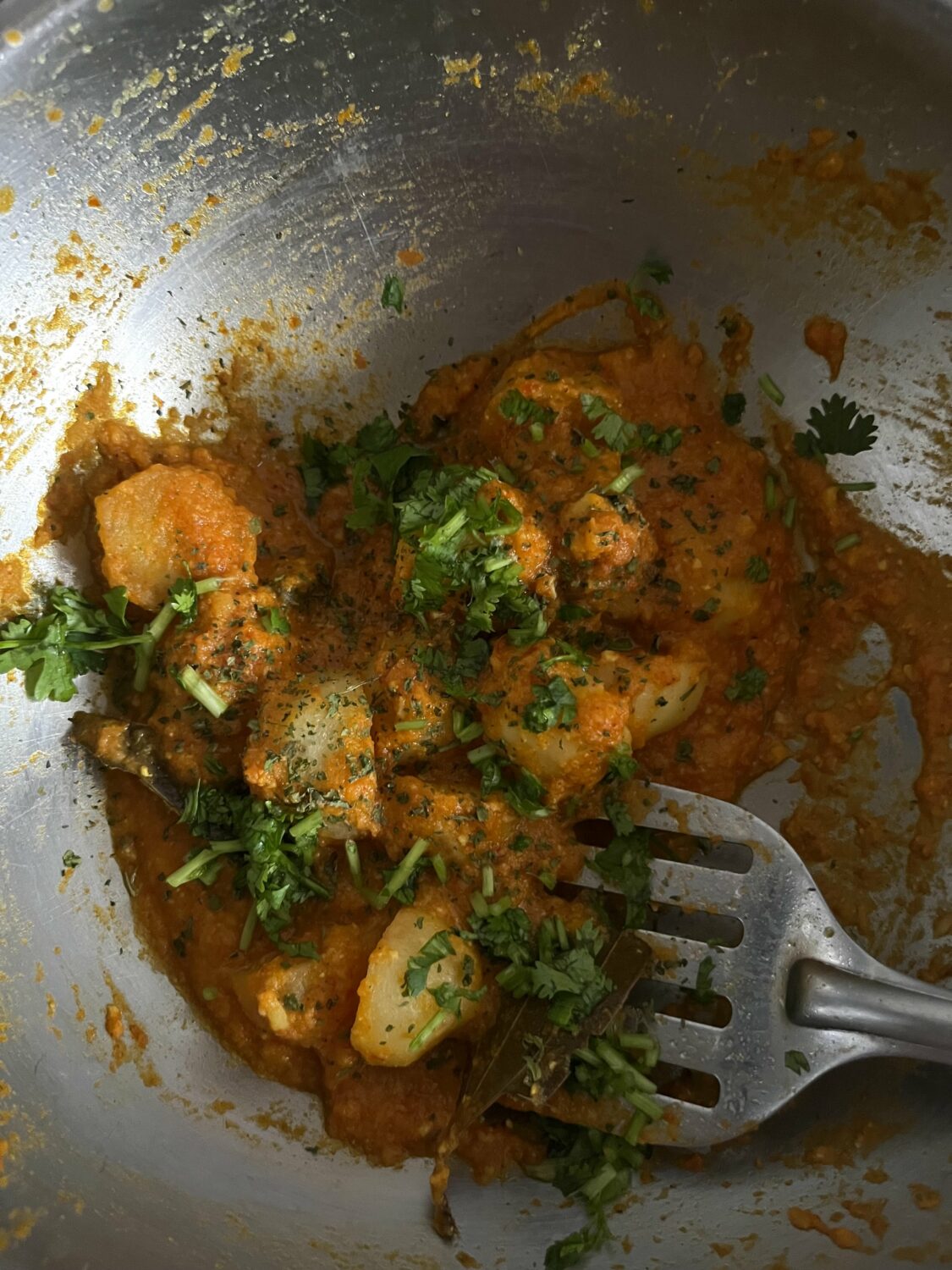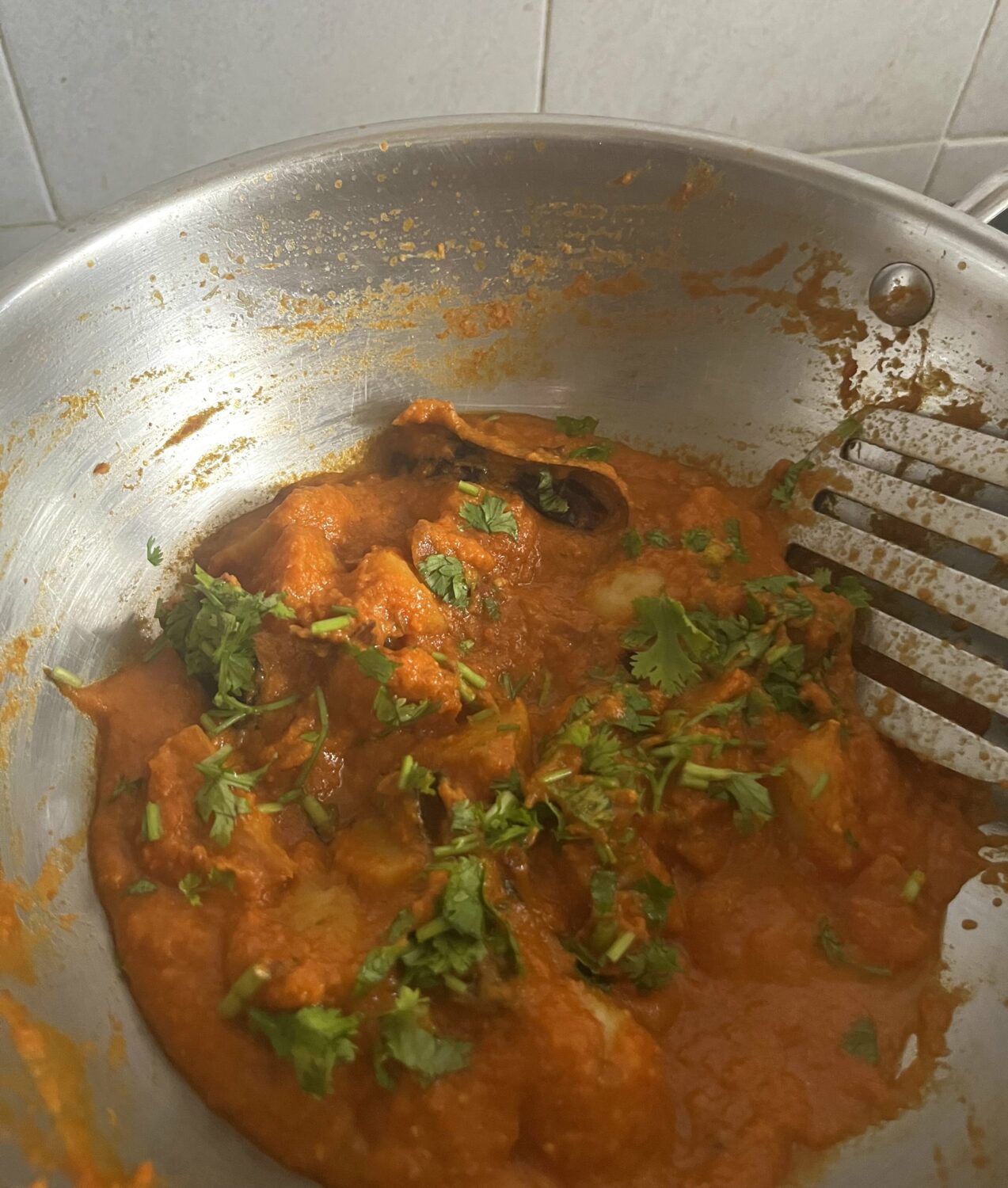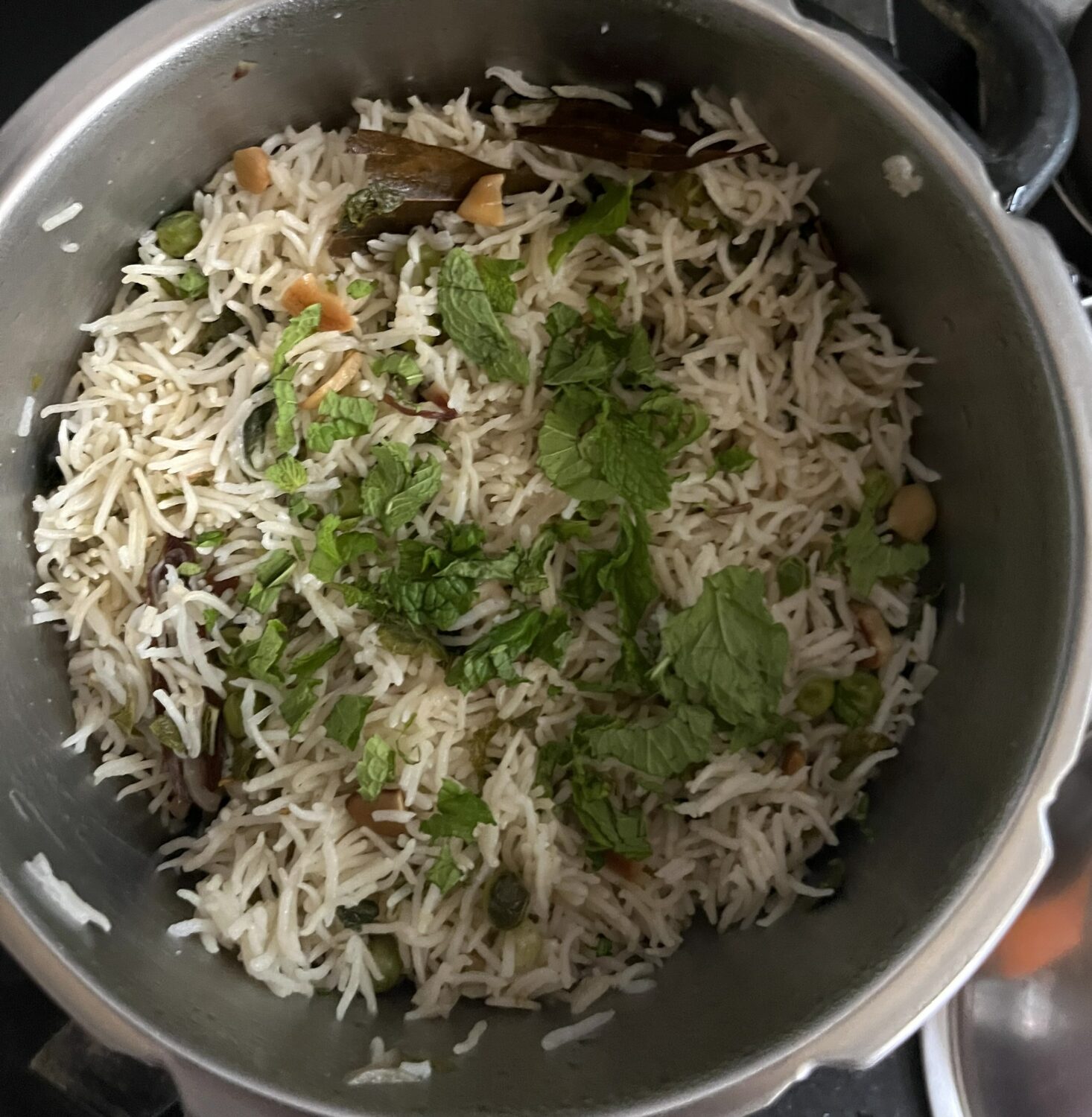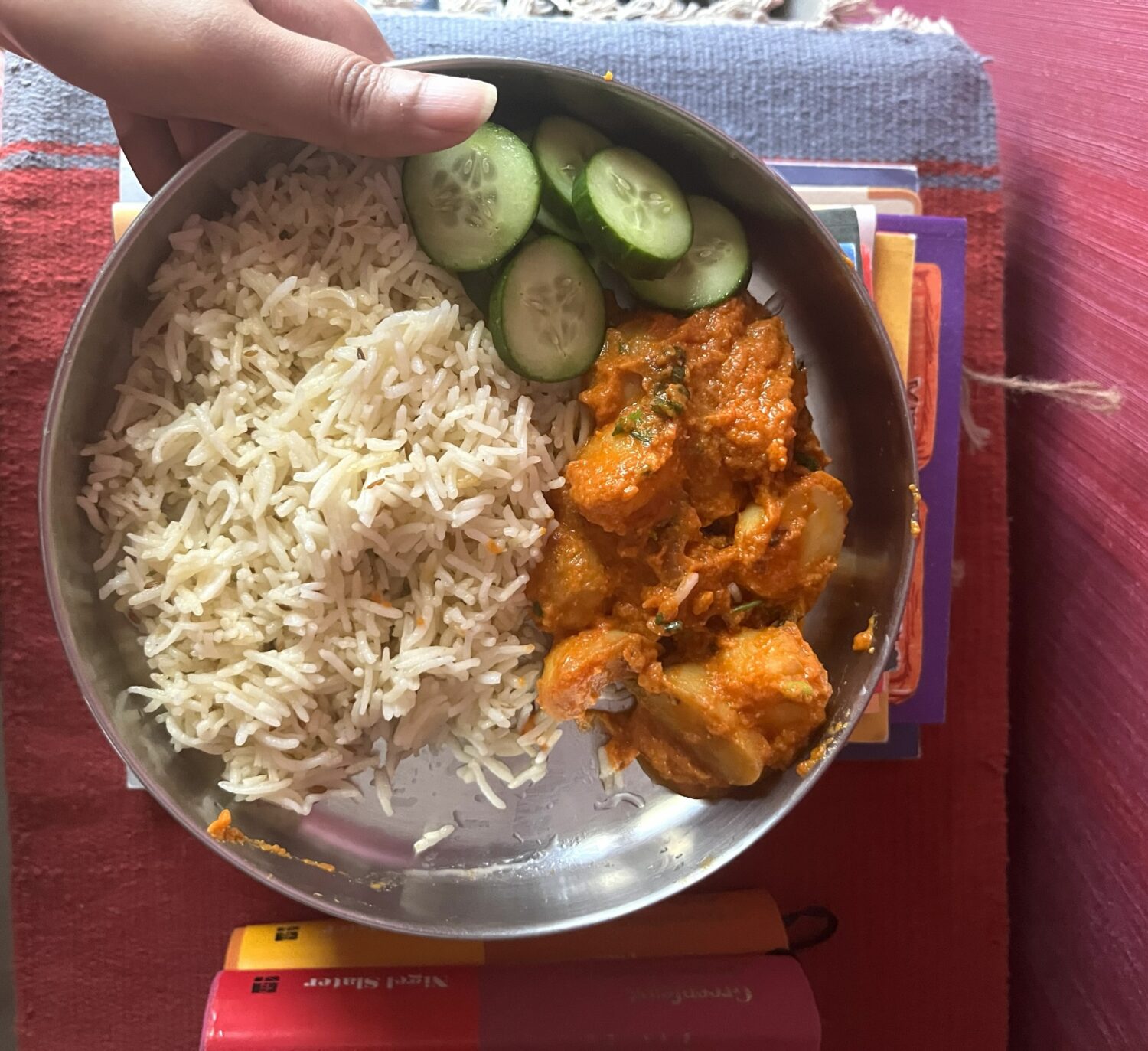An Inauthentic Curry for a Weekday Lunch: Mint and Peas Rice with Potato Curry
By Apoorva SripathiIs there such a thing as an authentic curry, especially since there are as many curry recipes as there are people in the subcontinent? This isn’t authentic in any absolute way, but it is authentic to me in that I have made it in my kitchen numerous times, each version differing from the other based on what I have on hand. It is rooted in a certain context, however.
This is my version of the popular curry ‘dum aloo’, which is a slow-cooked potato dish that’s made widely in the north and east of India, as well as in Pakistan. This recipe is perhaps more in line with what might be served at ubiquitous ‘Indian’ restaurants, whereas a traditional Kashmiri dum aloo recipe contains no onion, tomato, ginger, or garlic and is made entirely in mustard oil.
My version of this curry’s creaminess comes from both yoghurt and soaked cashews instead of heavy (or coconut) cream and if you skip the ghee and use coconut/soy yoghurt, it’s entirely vegan. Keeping with the context, the potatoes are parboiled and shallow fried in oil (you could deep fry them) for a textural contrast to the gravy that’s otherwise smooth and creamy. Feel free to adjust the quantity of spices and ingredients as well. (Note: my given quantities for six people might differ wildly from someone else’s idea of serving the same number!)
Moving out of context, I’ve paired this rich curry with an exceptionally fragrant mint rice: the more fresh mint you add, the better the flavour. It may seem like an oppressive amount of mint to add, but you want something strong to stand up to the luscious curry. Fried cashew nuts (in the rice) are optional and the sweet peas round everything off.
I often eat this on a Sunday, weekend cooking and eating at its best: meditative and indulgent, but it works on any day of the week, at any point in the year.

For 6 people as a main dish
Ingredients (You’ll need a blender for this recipe)
8 cashew halves, soaking in lukewarm water
6 shallots or 4 small Spanish onions, roughly chopped
3-inch piece ginger, roughly chopped
3-4 garlic cloves, crushed
8 medium ripe tomatoes, roughly chopped
600g baby new potatoes, parboiled, peeled, and halved
3 teaspoons cumin seeds
1 Indian bay leaf
2 cardamom pods, lightly crushed
A piece of a cinnamon stick
2 cloves
2 tablespoons yoghurt
3-4 teaspoons chilli powder
3-4 teaspoons cumin powder
3-4 teaspoons coriander powder
2 teaspoons fennel powder
1 tablespoon sugar
A pinch of dried fenugreek leaves (optional)
Oil for shallow frying, plus 5-6 tablespoons for the curry
2 tablespoons ghee
Salt to taste
For the rice
3 cardamom pods, lightly crushed
A piece of a cinnamon stick
2 cloves
1 Indian bay leaf
1 star anise
About 15-20 broken cashew nuts (optional)
2 medium Spanish onions or 4 shallots, thinly sliced
2 green chillies, slit down the middle
30g + 5g mint leaves, roughly chopped
100g frozen peas
500g Basmati rice
4-5 tablespoons vegetable oil
1 tablespoon ghee
750ml water (or enough water that comes to the knuckle of the tiny finger from the top)
Salt to taste

Method
Begin with washing the rice. Soak it in water for 30 minutes. Drain the water and retain the rice in the bowl.
While the rice is soaking, add four cashew halves, the shallots/onions, ginger and garlic into a blender and blend into a smooth paste without water. Set this paste aside. To the same blender, add the remaining cashew halves and the tomatoes and blend into a paste. Prick the potatoes all over with a fork.
In a large wok/pot/Dutch oven over medium-high heat, add enough oil to cover the bottom and slide in the potatoes. Make sure to not overcrowd the pan. When the potatoes are golden, turn them over. When they are golden all around (a little golden brown is fine), transfer them to a dish with a slotted spoon. Keep the wok to make the curry.

If you want to make the rice in between frying the potatoes: Add two tablespoons of oil and the tablespoon of ghee to a pot over medium-high heat. Add in the whole spices (cardamom, cinnamon, cloves, bay leaf, and star anise) and cashew nuts and fry till the cashews are golden brown and the spices are fragrant.
Before the cashews turn a dark brown, quickly add the onions/shallots along with a pinch of salt and fry them until the onions change colour from a light purple to golden brown. Onions tend to stick so add the remaining teaspoon of oil and keep stirring. You can add splashes of water to deglaze the pan as well.
Once the onions are soft and golden brown, add the chillies and fry for 20 seconds. Add 30g mint and stir till it wilts. Toss in the peas and fry for a few seconds then add in the rice and stir till everything is mixed well. Pour in the water and mix. Taste for salt and adjust as necessary. The water should taste a touch saltier than needed.
Bring to the boil over medium heat and once boiling, reduce the heat. Simmer until the rice is cooked through and has absorbed all of the liquid. Push a fork into the rice and gently push the grains aside to see if the water has been absorbed. Once the rice is cooked, switch the stove off, toss in the remaining mint, cover the pot with a clean kitchen towel, and close it down tightly with a lid. This will absorb any remaining water and keep the grains fluffy.

For the curry: To the same wok over medium-high heat, add the ghee and a 5 tablespoons of oil. Add the cumin seeds and stir until fragrant, about half a minute. Then add the bay leaf, cardamom pods, cinnamon stick, and cloves and fry until fragrant, about half a minute.
Lower the heat and add the onion-cashew paste (it tends to splutter a lot so stand back) and stir continuously since the paste tends to catch at the bottom. Deglaze with small splashes of water as and when necessary and keep stirring. The paste has to cook and change colour to a light golden brown and it takes a good 8-10 minutes or so. Halfway through, add in the yoghurt and keep stirring.
Once the mixture has reduced in quantity and changed colour (you might also see some oil on the sides), stir in the tomato-cashew paste along with a quarter cup of water. Add the fennel, cumin, coriander, and chilli powders, along with a pinch of salt and sugar. Stir everything, reduce the heat, and cover with a lid. Keep checking on this every few minutes — the gravy will change colour from a dull red to a bright orange-red and reduce in quantity.
Once most of the water has evaporated and the gravy looks more homogenous when you stir (there won’t be any excess water on top), slide in the potatoes and stir everything together. Taste for salt. Simmer for about a minute and before switching off the stove, crush the dried fenugreek leaves in between your palms and sprinkle on top of the gravy. Since this has cashew paste, the gravy tends to thicken as it sits, so add in a splash of water to reach the desired consistency.
Spoon the hot rice on one side of the plate and the potato curry on the other side. Serve with yoghurt, if you like.
Apoorva Sripathi is a writer and editor from Chennai, and the co-founder of the independent magazine CHEESE. She also writes shelf offering, a food and culture newsletter. Photography by Apoorva Sripathi.